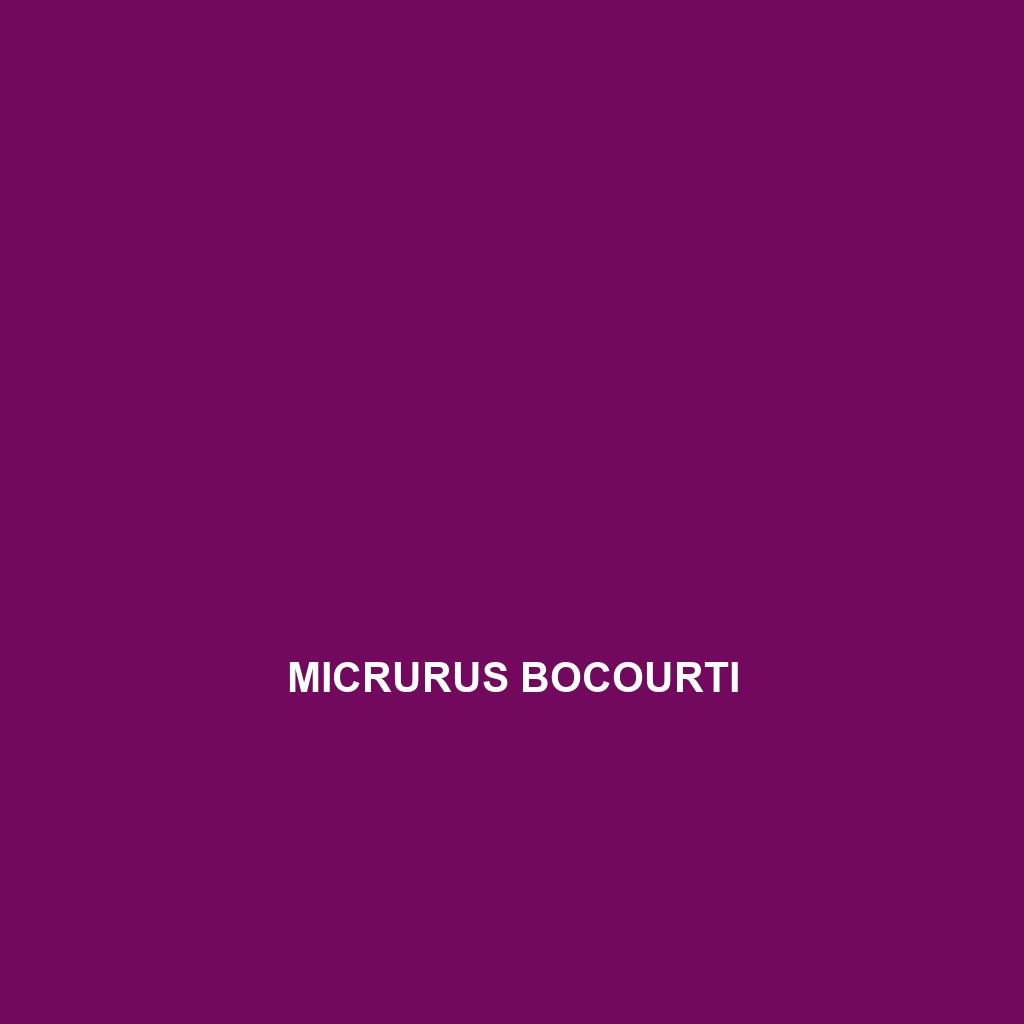Common Name
Micrurus bocourti
Scientific Name
Micrurus bocourti
Habitat
Micrurus bocourti, commonly known as Bocourt’s coral snake, primarily inhabits tropical rainforests and their edges across Central America, particularly in countries like Costa Rica, Nicaragua, and Honduras. These snakes thrive in environments that provide ample cover and humidity, typically favoring shaded areas near streams or in leaf litter. The warm, humid climate of these rainforests is ideal for their survival, while the diverse vegetation offers both refuge and hunting grounds. In addition to rainforests, they may also be found in adjacent savannas and temperate forests, where they continue to benefit from the varied microhabitats that these regions provide.
Physical Characteristics
Micrurus bocourti exhibits striking physical characteristics that distinguish it from other snake species. Adults typically range from 60 to 90 cm in length, featuring a slender body shape. The coloration is one of its most remarkable attributes; they present bold, alternating bands of red, yellow, and black that serve as both a warning to potential predators and as camouflage within the forest underbrush. Their smooth scales and elongated, triangular head further enhance their unique appearance. This distinctive color pattern not only contributes to their aesthetic appeal but also plays a critical role in their survival as a venomous species.
Behavior
Bocourt’s coral snake is largely a nocturnal species, engaging in most of its activity after sunset. During the day, they are often found hidden beneath leaf litter or within dense undergrowth, which provides protection from both predators and environmental elements. Their social interactions are generally limited, displaying solitary behavior except during the breeding season. Mating rituals involve intricate courtship displays, where males engage in physical contests for dominance over females. The low visibility of their nighttime activities makes them elusive, often leading to a rich tapestry of folklore and intrigue surrounding their behaviors.
Diet
Micrurus bocourti is primarily a carnivore, feeding on a diet that consists mainly of small reptiles, amphibians, and occasionally small mammals. Their method of hunting involves ambush tactics, utilizing their striking coloration for effective camouflage against the forest floor. With their potent venom, which primarily contains neurotoxins, Bocourt’s coral snakes are capable of subduing their prey swiftly before consumption. This snake species plays an important role in controlling the populations of various prey animals, contributing to the ecosystem’s balance.
Reproduction
The reproductive cycle of Micrurus bocourti usually takes place during the wetter months of the year, aligning with increased prey availability. After a courtship process, females lay a clutch of 3 to 12 eggs, typically hidden in moist, secluded environments to ensure higher survival rates of the offspring. The incubation period lasts approximately 60 to 90 days, during which the eggs mature. Once hatched, the juvenile snakes receive little to no parental care and must fend for themselves from an early age. This lack of parental involvement is not uncommon in many snake species.
Conservation Status
As of now, the conservation status of Micrurus bocourti is listed as Least Concern by the International Union for Conservation of Nature (IUCN). However, habitat loss due to deforestation and agricultural expansion poses significant threats to their populations. Efforts to conserve their natural habitats are imperative for ensuring the long-term survival of this unique species. Conservationists advocate for sustainable land use practices and the establishment of protected areas to safeguard the ecosystems where these snakes thrive.
Interesting Facts
One of the most intriguing facts about Micrurus bocourti is its ability to mimic the behavior of non-venomous snakes, which aids in evading predators. Additionally, their venom is highly potent, but bites to humans are rare due to the snake’s shy nature. Despite their fearsome reputation, these snakes are typically non-aggressive and will prefer to flee rather than confront a threat directly. Their unique coloration and patterns have sparked interest in the field of herpetology, as they are often studied for their behavioral ecology and venom compositions.
Role in Ecosystem
Micrurus bocourti plays a crucial role in its ecosystem as both a predator and prey species. As a predator, they help regulate populations of small reptiles and amphibians, aiding in maintaining ecological balance. Conversely, they serve as prey for larger predatory animals such as birds of prey and larger snakes. The presence of this species indicates a healthy ecosystem, as it requires specific environmental conditions to thrive. Furthermore, their role in the food web is essential for nutrient cycling and biodiversity conservation in their native habitats.
